Installing and Adjusting European-Style Cabinet Hinges
You Will Need:
1. A phillips head screwdriver, but probably not the one you already have.
2. A really cool-looking, and sharp, 1 3/8 inch Forstner bit. The Europeans call this a 35 mm Forstner bit. Go figure. I forgot: a drill.
3. A hammer ("you can fix anything with a hammer". Actually my favorite tool of all tools is a mallet, you can really wail away and not damage much. Warn your cat.).
4. A cabinet, and a door for same. If you made the door the wrong size, shape, or without any right angles, now is a good time to go make a new one. Or better, make two.
5. A six-pack of beer, and someone who does not drink to drive and help you.
6. Optional: facial tissues. Do you cry easily?
Step 1: Finding hinges. Go online and try to find the right hinges for your job. This is fun! Unless you already know the catalog number of the thing you want, because you dreamed it, you will never figure out what to get. Try look at some of the PDF's on hinge Specs: WTF!? Try to understand the imported picture that is a xerox of a xerox of a xerox. Go back and re-measure, as if that will help. For fun, you can look at the 110° opening hinges I bought: http://woodworker.com/cgi-bin/fullpres.exe?PARTNUM=131-222&LARGEVIEW=ON ( no particular endorsement or criticism meant). Remember, a2 + b2 = c2. If you happen to figure out what "K" means in those pix, please let me know. Having trouble? Try some of the tech pix in the PDF's at another location: http://www.rockler.com/product.cfm?page=5408
Again, no particular criticism meant, there are lots worse. Now is a good time to have a second beer. Why didn't you just buy the cabinets at IKEA? TECH TIP: Did I mention that many imported and craft beers are higher alcohol content than standard US beers? Now is a good time to get your driver to take you to IKEA and the Big Box home store. At IKEA, try to take one of the cabinets apart, without being observed. Oh, that's how it works! At BigBox, go to hardware/ferreteria and find cabinet hinges. Look at one closely. Focus. WOW, that engineer was either brilliant or psychotic! The darn thing is incomprehensibly complex! This is worse than recessed lighting! Now that you understand, go back to some on-line source and pick out hinges using blindfold and pin, you can always return them later. The ones at BigBox are cheesy. Actually, the ones you pick on-line are going to be out of stock, so have a backup. Have a beer. Optional: you can try to call one of those cabinet hinge distributors on the phone (don't even bother with online or FAQ). They are mostly in the midwest, and everyone there is so calm and polite, they must take valium everyday at breakfast. So while you are crying (see item 6, above) the guy or girl on the other end, will calmly and clearly describe how to pick out hinges. I could tell her description was clear by the simple sentences, I just couldn't understand it, and did not want to be impolite.
Step 2: When Hinges Arrive (BTW: is there anyone living in house besides you? If so, trouble is undoubtedly brewing, because this project is taking so long, and there is polyurethane residue and sander dust in unexpected locations. If that person is not speaking to you, this is a definite sign of some unease. Maybe reconsider IKEA? Their cabinets look a bit cheap, but they are easily put together by anyone who understands pictograms. If you meet that person, could you send me name and number?) Back to hinge: Sit down with a beer and look at it. How does it work? Here's an odd engineering fact: no one knows! Maybe it will become more clear as you go on. Maybe not. You probably already decided how many hinges per door, but now is a good time to review. You bought two per door, so use two. Alternatively, consider your kid and German shepherd both swinging on door. Forgot that, didn't you? But thinking things through, visualize how much more work it will be to install three hinges instead of two; about 3/2 if my analysis is correct. And when they do break, you can always go to IKEA. Their cabinets didn't look so bad after all.
Step 3: Drilling! OK, take your door and try to figure out which is up and which is down, no that's the front, drill on the back! No, now it's upside down! OK; got it. Now, along one edge, mark two spots where you are going to drill. There is probably some system to figuring out where these spots ought to be. I sort of go with this: The two hinges (no way will I do three) are going to be located the same distance from the inside of the top and bottom of cabinet. For me this means I measure up 4+3/4 inches from the bottom of door (4 inches inside plus ¾ for overlay with edge of cabinet), and a calculated amount from top of door (4 inches for inside plus varied overlay with upper edge). Since my stock for cabinet walls is all ¾ inch, I drill in 7/8" from door edge. BTW: this is a good moment to reflect that everyone else doing this stuff has a drill press and you don't. So their holes are nice and straight and vertical, and they don't have to sit cross-legged on the kitchen floor with door on lap, and may not even cut themselves/their door when that sharp bit jumps out of the hole. Watch out for your femoral artery, it's a big one. I gave up marking with pencil because mark is not visible under the 1 3/8 inch wide bit. Instead, I use a hole punched with a nail set. I did not mention the nail set in the "you will need" list, did I? Remember not to work when consuming alcohol. And since you will be going back to BigBox, you need someone to drive. You should never operate a vehicle when angry. TECH TIP: Some companies sell a template for drilling. Although your significant other will be mad that the job is entering another wait phase, you could get one. I did. It's useless, if I understand it. Maybe there was a piece missing?) Drill the holes to the correct depth (HA! review note about drill press) After you get the holes drilled, note that you put them in the front of the door, not the back. When you flipped it over that last time, you also flipped sides. You know, the back is actually prettier, don't you think? Let's have it showing.
TECH TIP: brown nail polish does not adequately cover up places where you drilled right through the wood. I told you to make two doors. I forgot to mention the voluminous wood shavings thrown off by a Forstner bit. Cool! Reminds me of the New Testament.
Step 4: More Drilling, Some Screwing. Now is a good time to look again at that hinge. If you stick the lumpy part in the hole you just drilled, you can see there are two little holes at either side. Mark with nail set, and drill (NOT THAT DEEP! but you can hardly see the hole it made). Into these, use a screwdriver to install the two 5/8" stainless screws they sent. OK, you lost them, back to store.) Remember NO drinking and driving car or screws. But before you drill them (oops...), locate them by trying to make a straight line that intersects all 4 screw holes and is thus parallel to the door edge, if you drilled the two big holes correctly. Note item 6, above. Did I inquire earlier if you were married or had a significant other? Continue looking busy! We are almost done. At the end of this step, the two hinges ought to be well connected to the door, in a fashion that looks kind of straight and symmetrical. Show it to your spouse/friend. Nice work! Don't take questions.
Step 5: More Drilling and Screwing - Now hold door up to cabinet edge. Note that if you put hinge into open position, you can exactly hold up door to cabinet and see where everything is positioned, and if you put hinge in closed position and close door you can see if the door is straight, BUT YOU CAN'T DO BOTH AT SAME TIME. Have a beer. There ARE options here. I always imagined that if I had a small child (see Oliver Twist) I could position him/her inside cabinet with flashlight, nail set and screwdriver and while I adjusted the outside for straightitude, the kid could fasten it on (make that two kids). Alternatively, while no one is looking, take a 9" X 13" Corning glass bake pan, no that's not quite high enough. Take a bake pan on which you have placed a scrap of ¾ plywood that is just big enough to cover the pan, but small enough that it sometimes falls in. So Close, darn just a smidge too high! If only I could reach that piece of ½ inch stuff. Damn! Close enough! Now, figuring it's probably straight, kind of position one of the little tabby sort of thingies from hinge on the cabinet wall, use nail set to mark, then screw in ONE screw (this is not a time for big commitments). While holding onto the door, cautiously remove the bake pan. Oh, too bad! They are cheap at Target or WalMart. Now look at the whole ensemble (I say that word with a sort of Europeany accent). Does it look right? How would you know? It should kind of appear mostly vertical in the up and down parts and basically horizontal in the sideways parts. If so, mark and drill another hole through the other tabby thing, insert screw. Drum roll. Does it open and look straight? OK, is it BADLY off? Drive remaining two screws. If it looks like a cabinet door, and you can't actually see into cabinet when door is closed, you are ready for step 6.
Step 6: Adjusting European Hinges. I started this article, which I see has grown somewhat chatty, when I could not find hinge adjustment well-described on the web. The good news: these hinges (the real ones, not the BigBox ones) have adjuster screws for each of three directions, up/down, in/out, side/side. It can be proven geometrically, starting with simple physical principles and theoroms from Euclid and others, that it is possible to adjust these hinges to make the door fit in the way you want. The bad news: it can't actually be done. This undoubtedly has to do with the square root of negative 1. A couple of preliminary approaches, just so you can feel that you tried:
A) Scientific reasoning. This appeals to me. If I adjust the in/out screw this way, then this will happen, right? Not quite. Here's the article I found that got me started: http://homerenovations.about.com/od/kitchens/a/artadjusthinges.htm
The key section, quoting at length:
"Unfortunately, there’s no exact science to adjusting European-style hinges. You’ll have to resort to trial and error at this point, experimenting with the depth screw and side screw to get the desired result. Turn the screw and move the cabinet door to the desired position. Close the cabinet doors to see whether the fit is good. If the doors still need adjusting, try again."
B) Try again. See item 3 in the "you will need" list. Have a beer. You know, now that you look at it, the little angle there seems kind of jaunty, don't you think? Remember the Navajo thing about leaving a mistake. OK two mistakes, not counting the practically invisible screw holes. Let's just call it done. Have a beer.
In closing, let me quote the following portion of a cabinetmaker job description from Craigslist (Seattle, around June 8, 2009):
"Capable to install and troubleshoot European hinge hardware and drawer slides.
Drug & alcohol free."
That job is not going to be filled.
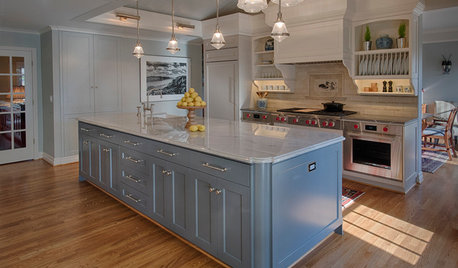
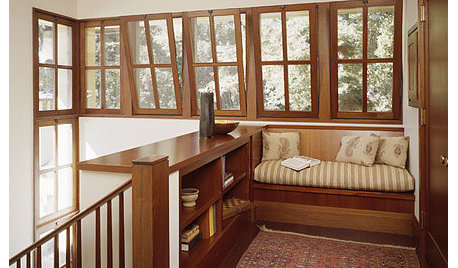
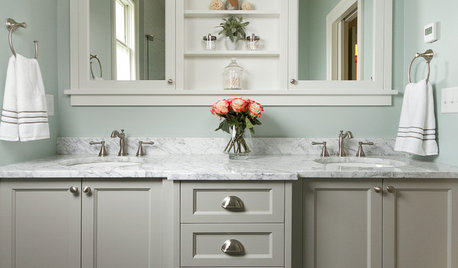
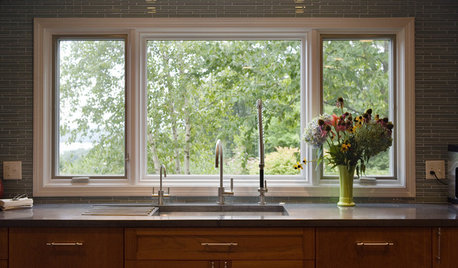

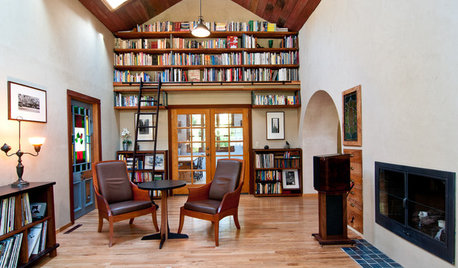
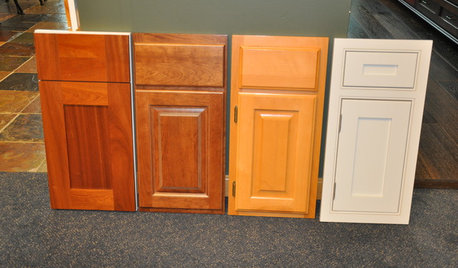
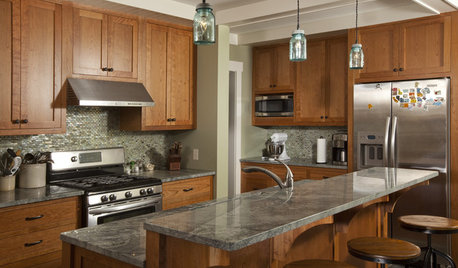
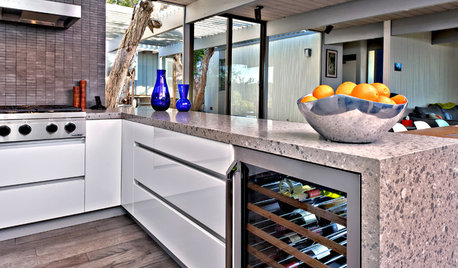
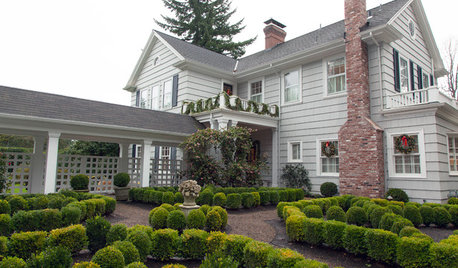






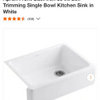
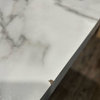
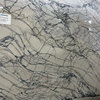
jdesign_gw
shelayne
Related Professionals
Kalamazoo Kitchen & Bathroom Designers · Pleasanton Kitchen & Bathroom Designers · Woodlawn Kitchen & Bathroom Designers · South Farmingdale Kitchen & Bathroom Designers · Cocoa Beach Kitchen & Bathroom Remodelers · Elk Grove Village Kitchen & Bathroom Remodelers · Spokane Kitchen & Bathroom Remodelers · Forest Hills Kitchen & Bathroom Remodelers · Foster City Cabinets & Cabinetry · Holt Cabinets & Cabinetry · Lakeside Cabinets & Cabinetry · Radnor Cabinets & Cabinetry · Roanoke Cabinets & Cabinetry · Rowland Heights Cabinets & Cabinetry · La Canada Flintridge Tile and Stone ContractorsC Zixks